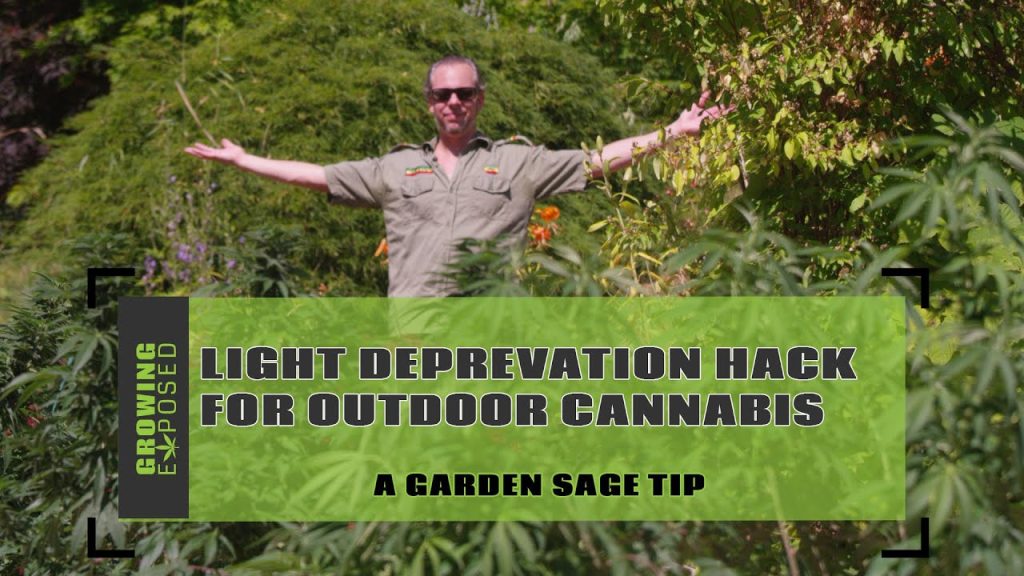If you live in a region with a short growing season, you’re probably wondering how you can maximize your garden’s growth in cool and wet climates. How do you grow outdoors and overcome the harsh environment when the summers are short, and the temperature starts to cool?
Light deprivation is a tried-and-true technique that tricks plants into flowering faster than the natural climate. In this episode of Growing Exposed, the Garden Sage gives us the 411 on a little-known light deprivation hack for outdoor growers.
What Is Light Deprivation?
Light deprivation, also known as light dep, is a cannabis cultivation technique that uses curtains, tarps, or other lightproof materials to block sunlight in outdoor and greenhouse gardens. How does this work? When they are tricked into thinking that fall came early, cannabis plants begin their natural flowering process.
Benefits of Light Deprivation
Using light deprivation techniques in your outdoor garden can have numerous benefits. One of the biggest benefits of light deprivation is the ability to flower early, which can be helpful if you live in a northern climate with short summers. Cannabis does not flower if it gets more than twelve hours of light.
Occasionally, growers can lose an entire growing season because they didn’t go into the flowering stage early enough. This could be devastating if you spend months and months in the crop’s vegetative stage. Even though the plants may be big, they may not have time to flower and can be at risk of mold.
When we visited the Garden Sage, he explained the benefits of light deprivation like this.
“The strains you can cultivate of cannabis outside the Kootenays are very specialized. Special strains were bred in this region for them to be able to finish their flower production in the natural climate.”
“A lot of times we’ll see in northern climates like this that plants don’t start flowering till September, and that’s actually when the daily light levels start dropping off. The weather starts cooling off. Rain starts coming. And sometimes our plants are done before they barely even get started, or flower production is finalizing in October, and we’re starting to see mold.”
“You want your plants flowering during peak conditions. You don’t want to see them flowering while the daily light is dropping off, and temperatures are dropping off, and the weather’s turning [cold]. Ultimately, that’s not going to lead to the maximum potential of those genetics.
Light Deprivation Hack: Trash Bags
On our visit to the Garden Sage’s garden in the Kootenays, we got some wisdom from the Sage about a quick, affordable, and easy-to-set-up light deprivation hack for outdoor cultivation.
If you live in northern climates, you know all too well that the weather and seasons can be against you when you’re growing cannabis.
Did you know that a heavy-duty black trash bag is all you need to overcome the early fall?
How to use trash bags for light deprivation in outdoor gardens:
- Put a garbage bag over your cannabis plants daily at 6 p.m.
- Pull the garbage bag off at 10 p.m. or when it gets dark.
- Repeat the process for two weeks.
Cannabis plants should start flowering after you limit light exposure and stay flowering. Although you may see a bit of elongation and loose flower development, this is because the days are a bit longer than the plants are used to when flowering.
If you cover them with a light deprivation tarp, bag, or any other lightproof material, this can increase the humidity, so you have to keep an eye on your plants and ensure they have some airflow to get quality flower.
When to Use Light Deprivation
In northern climates, cannabis plants can complete their flowering in October or even November, increasing the risk of bud rot due to the rain and cool temperatures. If you use the light deprivation technique, you can start flowering in July and remove the light deprivation when the daylight gets shorter.
How to Cover Cannabis Plants
Light deprivation can be done in various ways, including covering up individual plants or an entire light deprivation greenhouse. Whether growing outdoors or in light deprivation greenhouses, you want to avoid light leaks through the material since this can affect the growth and cause hermaphroditism.
One of the best ways to cover your plants is to use a thick and lightproof tarp, plastic, or cloth covering, or a heavy-duty garbage bag. You can also move them into a dark room if they’re in a pot and are easy to carry.
Consider the Flowering Growth Spurt
Once you cover your plants, they can grow nearly double in size in the flowering stage. Consider this when covering your plants. Ensure that your cover is large enough to contain the plants’ potential size after a few weeks of flowering.
Become a Better Grower with Growing Exposed on YouTube
Now that you know how to make your cool and wet climate work for you, you can go out there and start harvesting bountiful yields in no time. For more insider tips on indoor and outdoor cannabis cultivation, subscribe to the Growing Exposed Youtube channel and hit the notification bell to watch episodes as soon as we release them.
Level Up Your Cannabis Garden with Growing Exposed
Ready to optimize your indoor or outdoor cannabis garden? Subscribe to Growing Exposed’s YouTube channel for a behind-the-scenes look into the world’s most successful gardens and interviews with industry leaders in the cultivation space changing the game.








